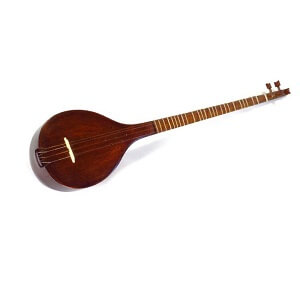Setar
 The setar is a Persian (Iranian) stringed instrument with a small, pear-shaped soundbox and four metal strings. Its name means “three strings.” A fourth drone string was added about 150 years ago by the mystic Moshtagh Ali Shah. The drone string is referred to as the “Sim Moshtagh” (Moshtagh string) by many prominent tar and setar players.
The setar is a Persian (Iranian) stringed instrument with a small, pear-shaped soundbox and four metal strings. Its name means “three strings.” A fourth drone string was added about 150 years ago by the mystic Moshtagh Ali Shah. The drone string is referred to as the “Sim Moshtagh” (Moshtagh string) by many prominent tar and setar players.
This modification gave the delicate instrument a “bigger” sound and more complex tuning possibilities. The resonating box of the setar is attached to a long neck that has twenty-five gut frets. The soundbox is made from mulberry wood, while the neck comes from the walnut tree. The instrument has a melodic range of just over twenty scale degrees. Although it is traditionally played with the right index finger’s nail, in the past three decades, two distinguished master performers, Mohammad-Reza Lotfi and Hossein Alizadeh, have introduced new techniques to give setar playing a whole new life.
Today the setar is generally considered the supreme instrument for performing Persian classical music. Due to new playing techniques, its evolution, and new approaches to melodies within Persian classical music boundaries, the setar has opened the door to contemporary compositions.